Article contents
A second-order constitutive theory for polyatomic gases: theory and applications
Published online by Cambridge University Press: 03 March 2023
Abstract

In the classical irreversible thermodynamics (CIT) framework, the Navier–Stokes–Fourier constitutive equations are obtained so as to satisfy the entropy inequality, by and large assuming that the entropy flux is equal to the heat flux over the temperature. This article is focused on the derivation of second-order constitutive equations for polyatomic gases; it takes the basis of CIT, but most importantly, allows up to quadratic nonlinearities in the entropy flux. Mathematical similarities between the proposed model and the classic Stokes–Laplace equations are exploited so as to construct analytic/semi-analytic solutions for the slow rarefied gas flow over different shapes. A set of second-order boundary conditions are formulated such that the model's prediction for the drag force is in excellent agreement with the experimental data over the whole range of Knudsen numbers. We have also computed the normal shock structure in nitrogen for Mach  ${Ma} \lesssim 4$. A very good agreement was observed with the kinetic theory, as well as with the experimental data.
${Ma} \lesssim 4$. A very good agreement was observed with the kinetic theory, as well as with the experimental data.
JFM classification
- Type
- JFM Papers
- Information
- Copyright
- © The Author(s), 2023. Published by Cambridge University Press
References
- 3
- Cited by





